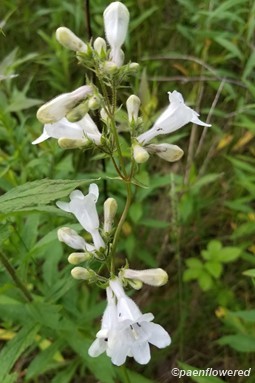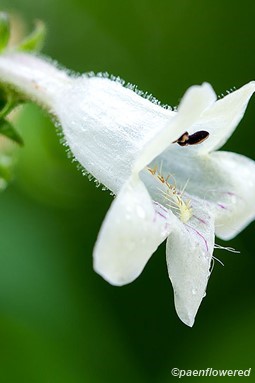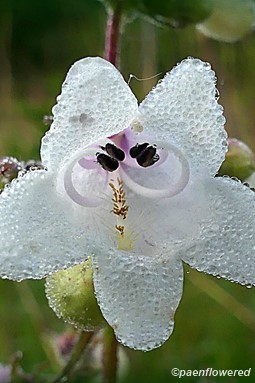Penstemon digitalis
One of the most common species of beardtongue in the state
Penstemon digitalis tall white beardtongue
Plants in the beardtongue group of wildflowers can be very difficult to identify since there are about 240 native species in the United States. The white beardtongue is one of the more common in this area. It is a native perennial and belongs to the plantain family, though it was previously assigned, based on the shape of the flowers, to the snapdragon (Scrophulariaceae) family. It is found in northeastern and central United States and in scattered locations in the mountains of the Southeast. It is found throughout Pennsylvania.
The beardtongue flowers are named for the tuft of hairs on one of the stamens that lies on the bottom of the inside of the corolla, and looks a bit like a hairy tongue. This stamen is one of five in the flower and is sterile. The 1-inch long white (sometimes pinkish) tubular flowers arise in pairs in clusters at the top of a terminal stem. They have five lobes, 2 fused into and upper and 3 into a lower lip. In this species the upper lip is about the same size as the lower. There may be faint purple markings on the lobes that serve as nectar guides to insects. The flower tube is abruptly swollen in the middle. The outer surface of the flower is hairy, but the rest of the plant is hairless. The sterile stamen in this species is only sparsely or moderately hairy.
In this species of beardtongue the flowering stalk occupies the upper 1/3 of the plant’s height. The species name digitalis comes from the resemblance of the flowers on the stem to fingers on the human hand. The flowers attract hummingbirds and a variety of bees including honeybees and bumblebees. The hairs on the sterile stamen can catch on the hairs of the bee and cause the other stamens to bend down and deposit pollen on the insect.
The plant has a basal rosette of leaves that give rise to the flower stalks in the spring. The stem leaves are in pairs, have no stalks and are toothed. Birds generally do not eat the seeds and few animals regularly feed on the foliage. The white beardtongue grows 2-4 feet tall in moist, sandy soil in fields, prairies or open woods. It does best in full sun.
This is easy to grow in wildflower gardens and hybrids and cultivars have been created for that purpose. It blooms from May to June. It is also called the talus slope penstemon, smooth penstemon, foxglove beaqrdtongue or the foxglove pestemon.
Habitat & Range
Common in meadows, fields, and man-disturbed habitats.
Present throughout the state.
Range: Northeastern and central United States and in scattered locations in the mountains of the Southeast.
| EMP: | FAC |
|---|---|
| NCNE: | FAC |
Phenology
Flowers June through early August.
Plant Codes
S-rank: No rank
G-rank: G5 (Secure)










Comments
Have you spotted this plant in your area? We'd love to hear about your experience! Share your comments or questions about the plant below. Comments are moderated before posting.